Investigation, Pollution Mapping and Simulative Leakage Health Risk Assessment for Heavy Metals and Metalloids in Groundwater from a Typical Brownfield, Middle China
Abstract
:1. Introduction
2. Materials and Methods
2.1. Study Area
2.2. Samples Collection and Detection
2.3. Steady Two-Dimensional Water Quality Model
- (1)
- Only changes of pollutant concentrations in a longitudinal direction (X) and transverse direction (Y) were took into consideration;
- (2)
- Losses caused by the entrainment effects of sediments were not considered;
- (3)
- Only simplex continuous emission sources were took into account.
2.4. Health Risk Assessment
2.5. Multivariate and Spatial Analysis Methods
3. Results and Discussion
3.1. Basic Parameters and Mean Toxic Metal Concentrations in Groundwater from the Brownfield
3.2. Spatial Distribution of Toxic Metals in Groundwater from the Brownfield
3.3. Leakage Effects of Toxic Metals on Water Quality in Xiangjiang River
3.3.1. Effects under the Condition of Setting a Waterproof Curtain
3.3.2. Effects under the Condition of Not Setting a Waterproof Curtain
3.4. Leakage Health Risk Assessment of Toxic Metals
3.4.1. Non-Carcinogenic Risk Levels
3.4.2. Carcinogenic Risks Levels
3.5. Uncertainty Analysis
4. Conclusions
Supplementary Materials
Acknowledgments
Author Contributions
Conflicts of Interest
References
- Crevecoeur, S.; Debacker, V.; Joaquim-Justo, C.; Gobert, S.; Scippo, M.L.; Dejonghe, W.; Martin, P.; Thome, J.P. Groundwater quality assessment of one former industrial site in Belgium using a TRIAD-like approach. Environ. Pollut. 2011, 159, 2461–2466. [Google Scholar] [CrossRef] [PubMed]
- Pekey, H.; Karaka, D.; Bakoglu, M. Source apportionment of heavy metals in surface waters of a polluted stream using multivariate statistical analyses. Mar. Pollut. Bull. 2004, 49, 809–818. [Google Scholar] [CrossRef] [PubMed]
- Sharma, R.K.; Aqrawal, M. Biological effects of heavy metals: An overview. J. Environ. Biol. 2005, 26, 301–313. [Google Scholar] [PubMed]
- Makokha, V.A.; Qi, Y.; Shen, Y.; Wang, J. Concentrations, distribution, and ecological risk assessment of heavy metals in the east Dongting and Honghu Lake, China. Expo. Health 2016, 8, 31–41. [Google Scholar] [CrossRef]
- Zeng, X.X.; Liu, Y.G.; You, S.H.; Zeng, G.M.; Tan, X.F.; Hu, X.J. Spatial distribution, health risk assessment and statistical source identification of the trace elements in surface water from the Xiangjiang River, China. Environ. Sci. Pollut. Res. 2015, 22, 9400–9412. [Google Scholar] [CrossRef] [PubMed]
- Li, F.; Huang, J.H.; Zeng, G.M.; Yuan, X.Z.; Li, X.D.; Liang, J. Spatial risk assessment and sources identification of heavy metals in surface sediments from the Dongting Lake, Middle China. J. Geochem. Explor. 2013, 132, 75–83. [Google Scholar] [CrossRef]
- Chabukdhara, M.; Gupta, S.K.; Kotecha, Y.; Nema, A.K. Groundwater quality in Ghaziabad district, Uttar Pradesh, India: Multivariate and health risk assessment. Chemosphere 2017, 179, 167–178. [Google Scholar] [CrossRef] [PubMed]
- Galitskaya, I.V.; Rama, M.K.; Keshav, K.A.; Batrak, G.I.; Eremina, O.N.; Putilina, V.S.; Yuganova, T.I. Assessment of soil and groundwater contamination by heavy metals and metalloids in Russian and Indian megacities. Procedia Earth Planet. Sci. 2017, 17, 674–677. [Google Scholar] [CrossRef]
- Belkhiri, L.; Mouni, L.; Narany, T.S.; Tiri, A. Evaluation of potential health risk of heavy metals in groundwater using the integration of indicator kriging and multivariate statistical methods. Groundw. Suatain. Dev. 2017, 4, 12–22. [Google Scholar] [CrossRef]
- Zhang, Y.; Li, F.D.; Ouyang, Z.; Zhao, G.S.; Li, J.; Liu, Q. Distribution and health risk assessment of heavy metals of groundwater in the irrigation district of the lower reaches of Yellow River. Environ. Sci. 2013, 34, 121–128. [Google Scholar]
- Ministry of Environmental Protection, PRC. Chinese Environmental State Bulletin in 2015; Ministry of Environmental Protection, PRC: Beijing, China, 2016. Available online: http://www.zhb.gov.cn/gkml/hbb/qt/201606/W020160602413860519309.pdf (accessed on 20 May 2016).
- Li, K.J.; Gu, Y.S.; Li, M.Z.; Zhao, L.; Ding, J.J.; Lun, Z.J.; Tian, W. Spatial analysis, source identification and risk assessment of heavy metals in a coal mining area in Henan, Central China. Int. Biodeterior. Biodegrad. 2017. [Google Scholar] [CrossRef]
- Shi, L.Y.; Cao, Y.Z.; Zhang, J.L.; Li, F.S. Comparison of application of RBCA and CLEA model for health risk assessment of a heavy metal contaminated site. Res. Environ. Sci. 2009, 22, 241–247. [Google Scholar]
- Ahmadi, S.H.; Sedghamiz, A. Geostatistical analysis of spatial and temporal variations of groundwater level. Environ. Monit. Assess. 2007, 129, 277–294. [Google Scholar] [CrossRef] [PubMed]
- Lin, M.L.; Gui, H.R.; Peng, L.H.; Sun, L.H.; Chen, S.; Li, Z.C. Health risk assessment of heavy metals in deep groundwater from different aquifers of a typical coal mining area: A case study of a coal mining area in northern Anhui Province. Acta Geosci. Sin. 2014, 35, 589–598. [Google Scholar]
- Li, Z.H.; Zhang, S.; Bi, E.P.; Yu, J.; Wang, W.Z.; Ma, L.S. The health risk assessment of groundwater organic pollution at a certain oil depot. Acta Geosci. Sin. 2010, 31, 258–262. [Google Scholar]
- Li, F.; Zhang, J.D.; Yang, J.; Liu, C.Y.; Zeng, G.M. Site-specific risk assessment and integrated management decision-making: A case study of a typical heavy metal contaminated site, Middle China. Hum. Ecol. Risk Assess. 2016, 22, 1224–1241. [Google Scholar] [CrossRef]
- Li, F.; Zhang, J.D.; Jiang, W.; Liu, C.Y.; Zhang, Z.M.; Zhang, C.D.; Zeng, G.M. Spatial health risk assessment and hierarchical risk management for mercury in soils from a typical contaminated site, China. Environ. Geochem. Health 2016, 39, 923–934. [Google Scholar] [CrossRef] [PubMed]
- Huang, J.; Li, F.; Zeng, G.M.; Huang, X.; Liu, W.; Wu, H.; Gu, Y.; Li, X.; He, X.; He, Y. Integrating hierarchical bioavailability and population distribution into potential eco-risk assessment of heavy metals in road dust: A case study in Xiandao District, Changsha city, China. Sci. Total Environ. 2016, 541, 969–976. [Google Scholar] [CrossRef] [PubMed]
- Li, F.; Huang, J.H.; Zeng, G.M.; Huang, X.L.; Liu, W.C.; Wu, H.P.; Yuan, Y.J.; He, X.X.; Lai, M.Y. Spatial distributions and health risk assessment of heavy metals associated with receptor population density in street dust: A case study of Xiandao District, Middle China. Environ. Sci. Pollut. Res. 2015, 22, 6732–6742. [Google Scholar] [CrossRef] [PubMed]
- Li, F.; Huang, J.H.; Zeng, G.M.; Liu, W.C.; Huang, X.L.; Huang, B.; Gu, Y.L.; Shi, L.X.; He, X.X.; He, Y. Toxic metals in topsoil under different land uses from Xiandao District, middle China: Distribution, relationship with soil characteristics and health risk assessment. Environ. Sci. Pollut. Res. 2015, 22, 12261–12275. [Google Scholar] [CrossRef] [PubMed]
- Li, F.; Zhang, J.D.; Huang, J.H.; Huang, D.W.; Yang, J.; Song, Y.W.; Zeng, G.M. Heavy metals in road dust from Xiandao district, Changsha city, China: Characteristics, health risk assessment, and integrated source identification. Environ. Sci. Pollut. Res. 2016, 23, 13100–13113. [Google Scholar] [CrossRef] [PubMed]
- Ministry of Environmental Protection, PRC. Water Quality-Determination of Copper, Zinc, Lead and Cadmium-Atomic Absorption Spectrometry; GB/T 7475-87; Ministry of Environmental Protection, PRC: Beijing, China, 1987.
- Ministry of Environmental Protection, PRC. Water Quality–Determination of Mercury, Arsenic, Selenium, Bismuth and Antimony–Atomic Fluorescence Spectrometry; HJ 694-2014; Ministry of Environmental Protection, PRC: Beijing, China, 2014.
- Ministry of Environmental Protection, PRC. Environmental Quality Standards for Soils; GB 15618-2008; Ministry of Environmental Protection, PRC: Beijing, China, 2008.
- Ministry of Environmental Protection, PRC. Identification Standards for Hazardous Wastes-Identification for Extraction Toxicity; GB 5085.3-2007; Ministry of Environmental Protection, PRC: Beijing, China, 2007.
- Ministry of Environmental Protection, PRC. Water Quality-Determination of Chromium (VI)-1, 5-Diphenylcarbohydrazide Spectrophotometric Method; GB/T 7467-87; Ministry of Environmental Protection, PRC: Beijing, China, 1987.
- Ministry of Environmental Protection, PRC. Water Quality–Determination of Total Arsenic–Silver Diethyldithiocarbamate Spectrophotometric Method; GB 7485-87; Ministry of Environmental Protection, PRC: Beijing, China, 1987.
- Luo, D.G.; Wang, X.J.; Sun, L.N. Progress in study of water quality model and review of river basin management model-WARMF. Adv. Water Sci. 2005, 16, 290–294. [Google Scholar]
- Susilowati, Y.; Mengko, T.R.; Rais, J. Water quality modeling for environmental information system. IEEE Asia Pac. Conf. Circuit Syst. 2004, 2, 929–932. [Google Scholar]
- Koontanakulvong, S. Development and application of water quality model in urban drainage planning. Finite Elem. Water Resour. Proc. Int. Conf. 1992, 2, 753–761. [Google Scholar]
- Wool, T.A.; Davie, S.R.; Rodriguez, H.N. Development of three-dimensional hydrodynamic and water quality models to support total maximum daily load decision process for the Neuse River Estuary, North Carolina. J. Water Plan. Manag. ASCE 2003, 129, 295–306. [Google Scholar] [CrossRef]
- Wang, F.E.; Yang, J.; Li, Y.N.; Yang, X.Q.; Zhong, X.H.; Bian, J.Y. Modification of WASP model based on release of sediment phosphorus. Acta Sci. Circumstantiae 2013, 33, 3302–3308. [Google Scholar]
- Ditoro, D.M.; Sifitzpatrick, J.J.; Thomann, R.V.; Hydroscience, I. Documentation for Water Quality Analysis Simulation Program (WASP) and Model Verification Program (MVP). Prof. SPIE 1983, 34, 4–10. [Google Scholar]
- Lim, H.S.; Lee, J.S.; Chon, H.T.; Sager, M. Heavy metal contamination and health risk assessment in the vicinity of the abandoned Songcheon Au-Ag mine in Korea. J. Geochem. Explor. 2008, 96, 223–230. [Google Scholar] [CrossRef]
- De Miguel, E.; Iribarren, I.; Chacon, E.; Ordonez, A.; Charlesworth, S. Risk-based evaluation of the exposure of children to trace elements in playgrounds in Madrid (Spain). Chemosphere 2007, 66, 505–513. [Google Scholar] [CrossRef] [PubMed]
- Islam, M.S.; Ahmed, M.K.; Habibullah-Al-Mamun, M. Apportionment of heavy metals in soil and vegetables and associated health risks assessment. Stoch. Environ. Res. Risk Assess. 2016, 30, 365–377. [Google Scholar] [CrossRef]
- United States Environmental Protection Agency (USEPA). Risk Assessment Guidance for Superfund Volume 1. Human Health Evaluation Manual (Part E, Supplemental Guidance for Dermal Risk Assessment); EPA/540/R/99/005 Office of Superfund Remediation and Technology Innovation, Environmental Protection Agency: Washington, DC, USA, 2004.
- Iqbal, J.; Shah, M.H.; Akhter, G. Characterization, source apportionment and health risk assessment of trace metals in freshwater Rawal Lake, Pakistan. J. Geochem. Explor. 2013, 125, 94–101. [Google Scholar] [CrossRef]
- Ministry of Environmental Protection, PRC. Exposure Factors Handbook of Chinese Population (Adult Volume); China Environmental Science Press: Beijing, China, 2013.
- Li, F.; Huang, J.H.; Zeng, G.M.; Yuan, X.Z.; Liang, J.; Wang, X.Y. Multimedia health impact assessment: A study of the scenario-uncertainty. J. Cent. South Univ. 2012, 19, 2901–2909. [Google Scholar] [CrossRef]
- United States Environmental Protection Agency (USEPA). Risk Assessment Guidance for Superfund Volume 1. Human Health Evaluation Manual (Part A); EPA/540/1-89/002 Office of Emergency and Remedial Response, Environmental Protection Agency: Washington, DC, USA, 1989.
- United States Environmental Protection Agency (USEPA). Guidelines for Carcinogen Risk Assessment; EPA/630/P-03/001F Environmental Protection Agency: Washington, DC, USA, 2005.
- Xie, Y.; Chen, T.; Lei, M. Spatial distribution of soil heavy metal pollution estimated by different interpolation methods: Accuracy and uncertainty analysis. Chemosphere 2011, 82, 468–476. [Google Scholar] [CrossRef] [PubMed]
- Tang, G.A.; Yang, X. Geography Information System Space Analysis Experimental Tutorial; Science Press: Beijing, China, 2013. [Google Scholar]
- Watson, D.F.; Philip, G.M. A refinement of inverse distance weighted interpolation. Geo-Processing 1985, 2, 315–327. [Google Scholar]
- Liu, R.; Chen, Y.; Sun, C. Uncertainty analysis of total phosphorus spatial-temporal variations in the Yangtze River Estuary using different interpolation methods. Mar. Pollut. Bull. 2014, 86, 68–75. [Google Scholar] [CrossRef] [PubMed]
- Shepard, D. A two-dimensional interpolation function for irregularly-spaced data. ACM Natl. Conf. 1968, 23, 517–524. [Google Scholar]
- General Administration of Quality Supervision Inspection and Quarantine of China. Quality Standard for Ground Water; GB14848-93; General Administration of Quality Supervision Inspection and Quarantine of China: Beijing, China, 1993.
- Ministry of Environmental Protection, PRC. Environmental Quality Standards for Surface Water; GB3838-2002; Ministry of Environmental Protection, PRC: Beijing, China, 2002.
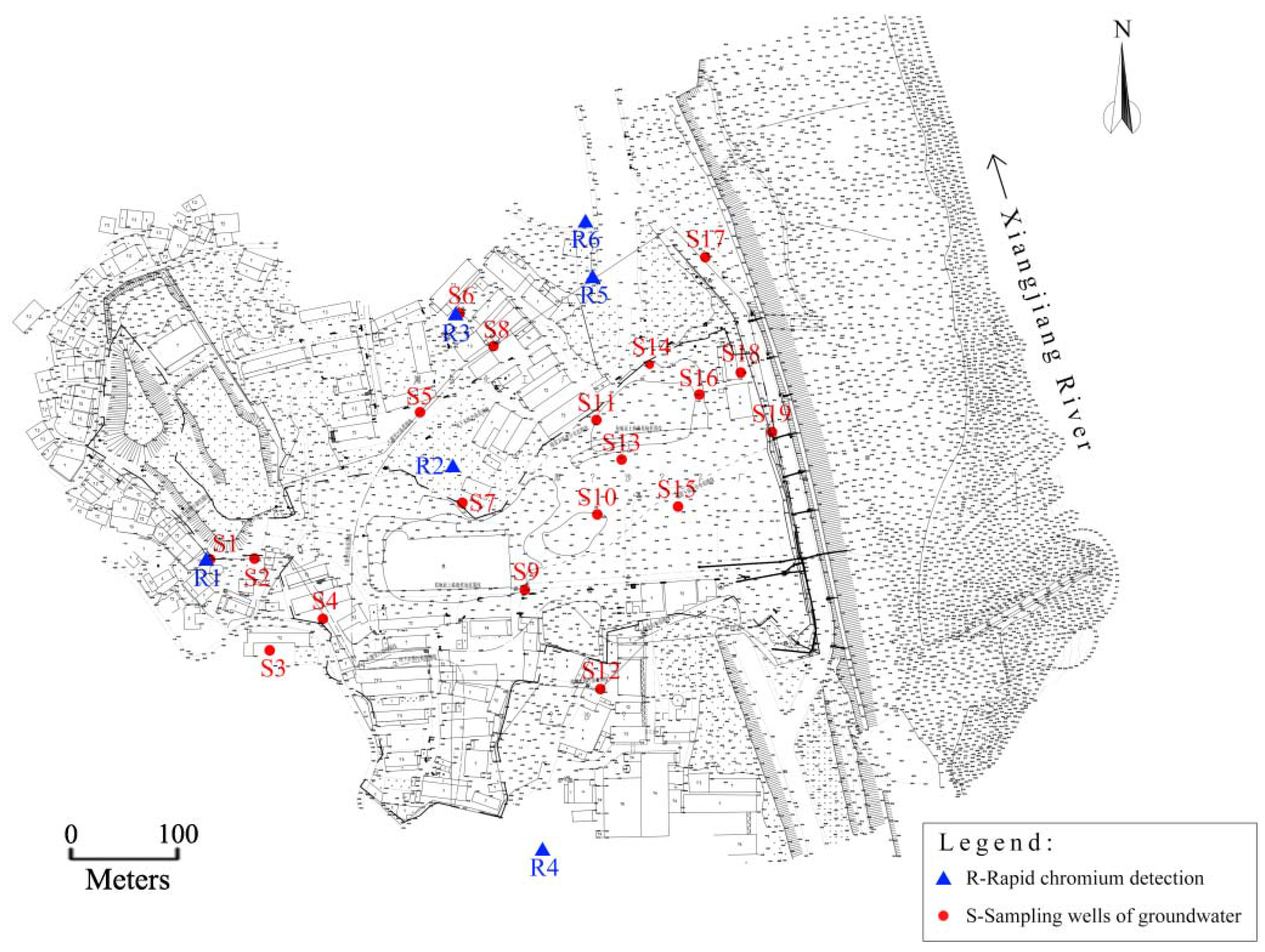
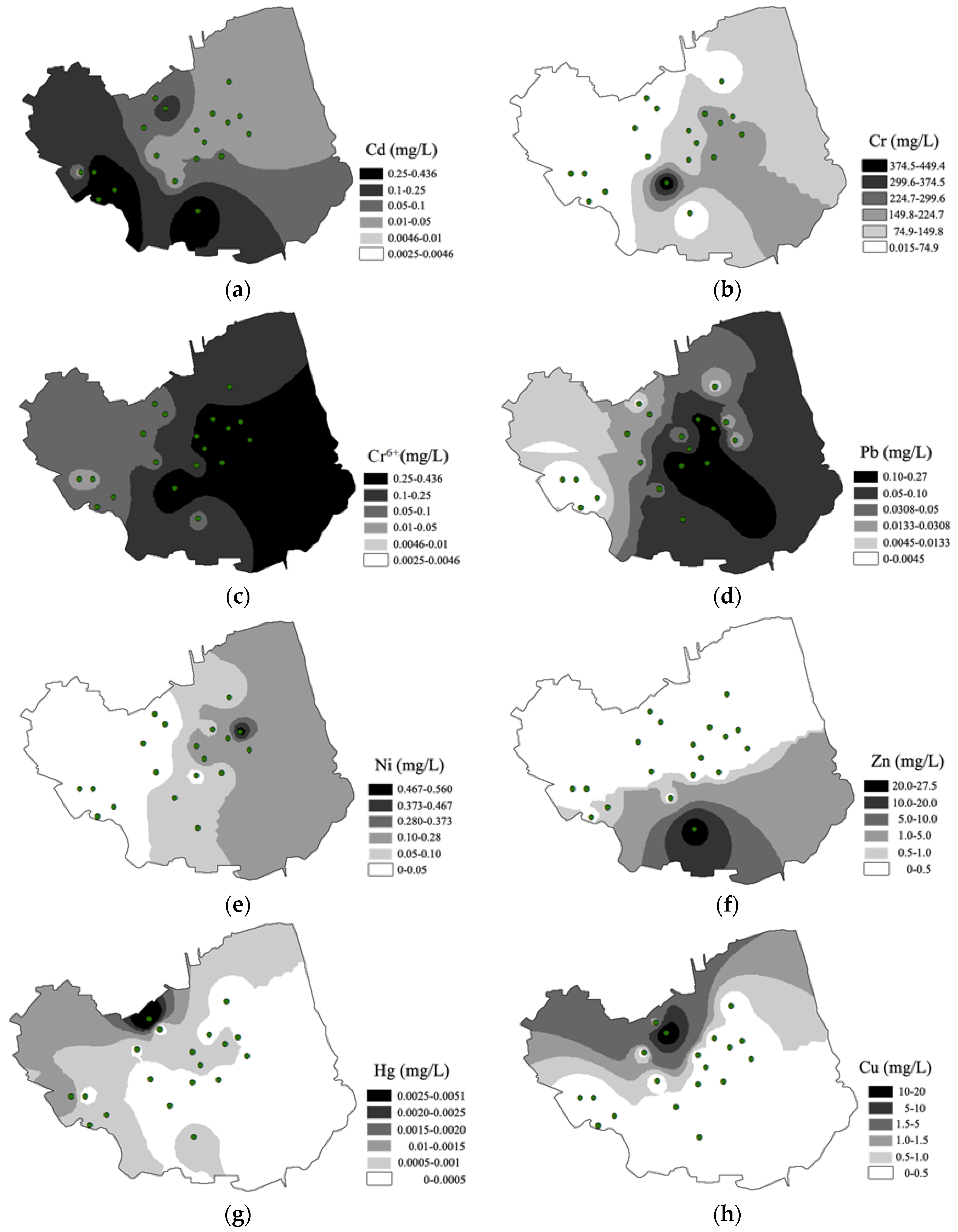
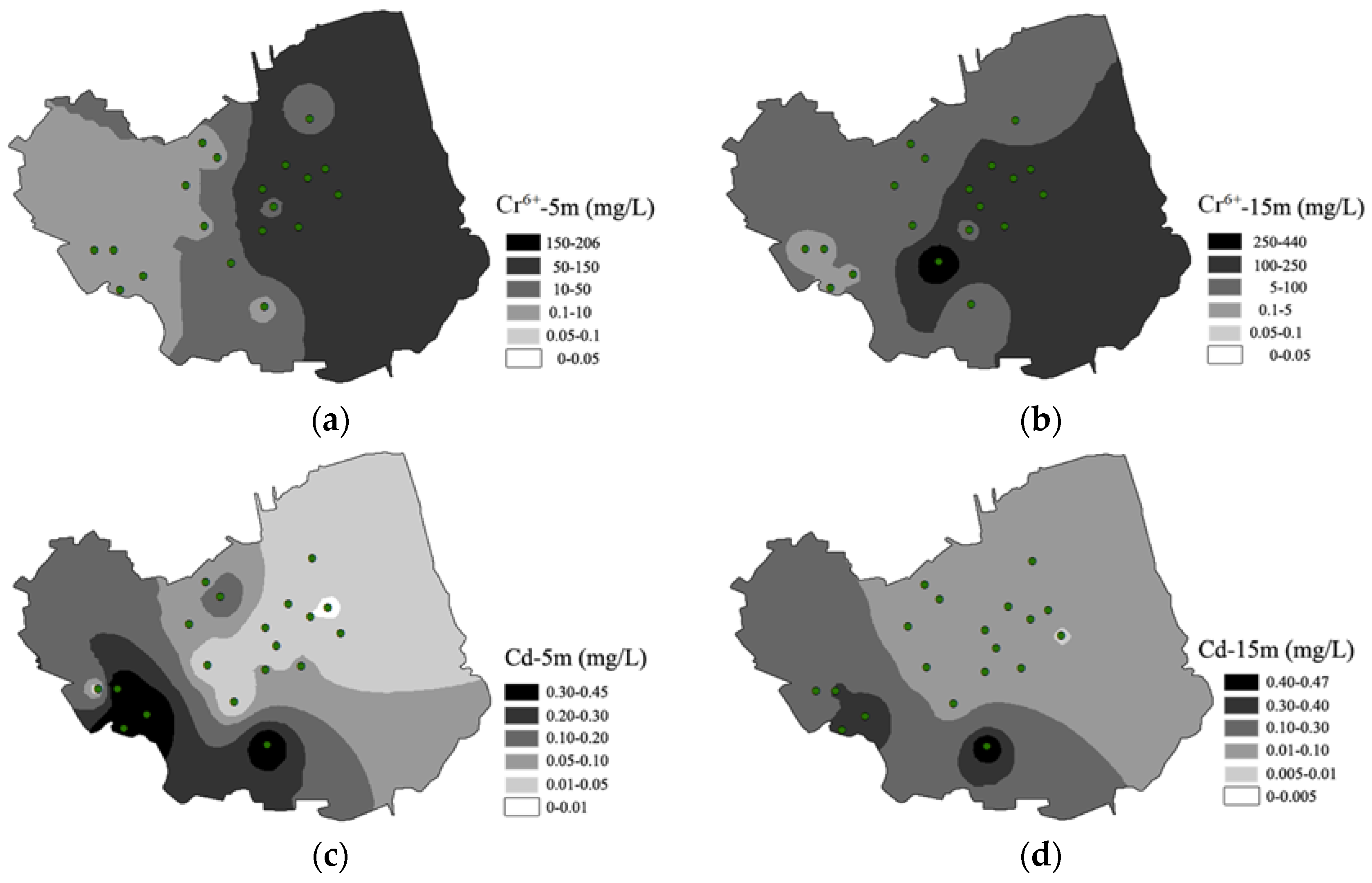

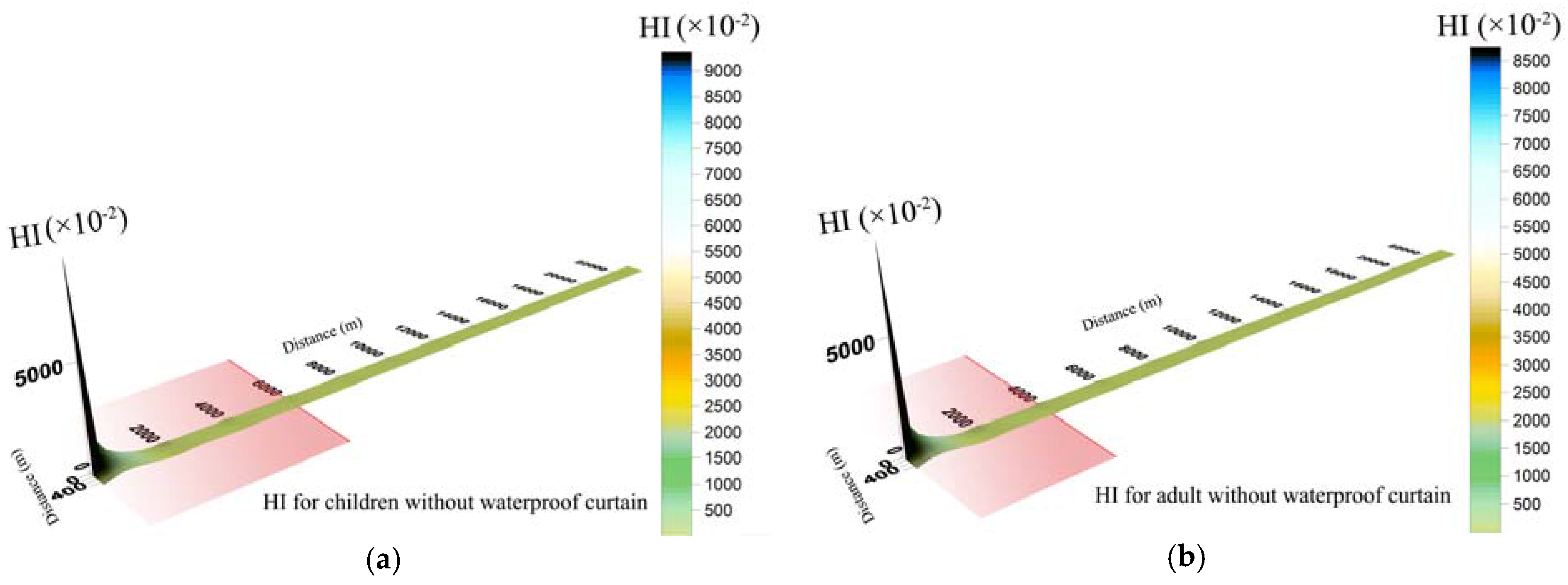

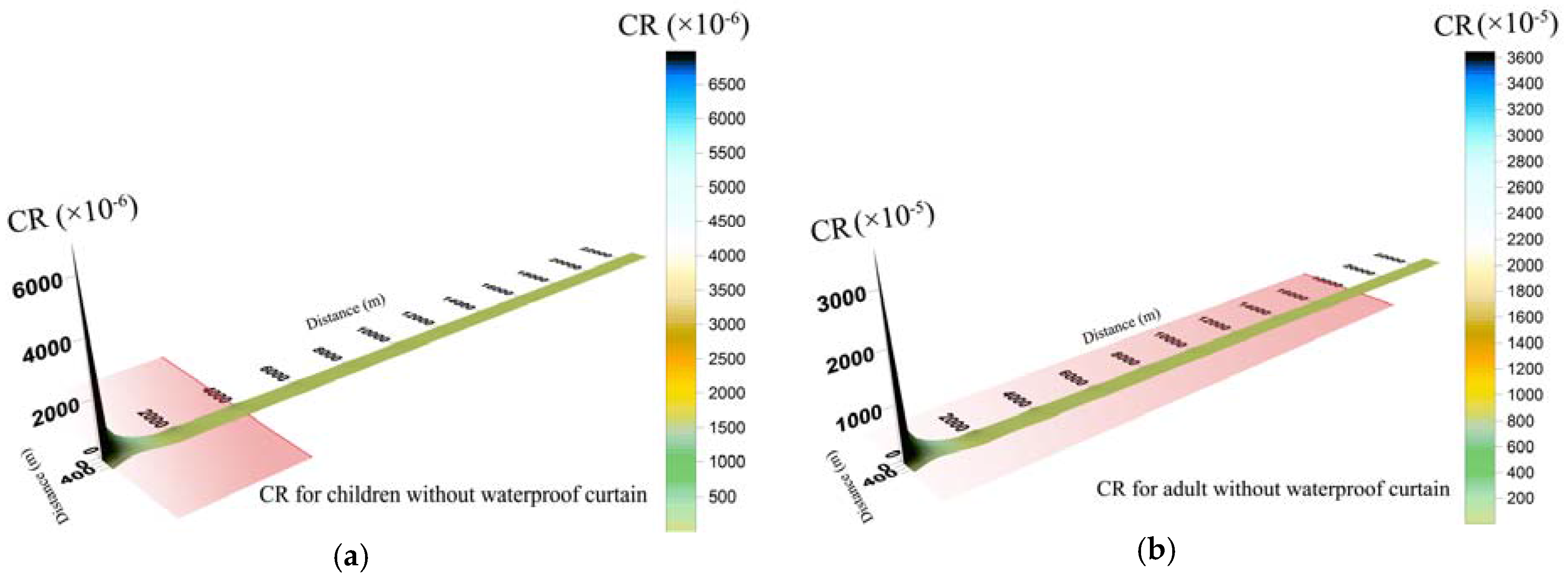
| Parameters | u (m/s) | My (m2/s) | H (m) | B (m) | k (Cr6+)·(d−1) | k (Cd)·(d−1) |
|---|---|---|---|---|---|---|
| Values | 0.095 | 0.154 | 7.3 | 794 | 0.5 | 0.39 |
| Parameters | pH | Total Hardness | CODCr | Ammonia Nitrogen | Sulfide | Sulfate | Fluoride | Nitrate |
|---|---|---|---|---|---|---|---|---|
| Mean | 8.12 | 483.97 | 397.13 | 2.33 | 0.052 | 828.21 | 5 | 1.47 |
| Max | 12 | 1510 | 5480 | 25 | 0.17 | 4180 | 29.2 | 8.42 |
| Min | 2.7 | 14 | ND a | 0.034 | ND | ND | ND | ND |
| Detection limit | 2–12 | 5 | 5 | 0.025 | 0.005 | 8 | 0.05 | 0.02 |
| N% b | 100 | 100 | 81.6 | 100 | 47.4 | 86.8 | 94.7 | 92.1 |
| Chinese standard c | 6.5–8.5 | 450 | 0.2 | 250 | 1 | 20 |
| Parameters | Cr6+ | Cr | Pb | Cd | Zn | Cu | Ni | Hg | As |
|---|---|---|---|---|---|---|---|---|---|
| Mean | 69.89 | 93.06 | 0.09 | 0.13 | 2.14 | 1.83 | 0.10 | 0.001 | ND |
| Max | 440 | 841 | 0.27 | 0.474 | 28.8 | 27.1 | 0.85 | 0.00535 | ND |
| Min | ND a | ND | ND | ND | ND | ND | ND | ND | ND |
| Detection limit | 0.004 | 0.03 | 0.01 | 0.0025 | 0.05 | 0.0025 | 0.006 | - | 0.007 |
| N% b | 94.7 | 94.7 | 57.9 | 92.1 | 76.3 | 57.9 | 81.6 | 73.7 | 0 |
| Chinese standard c | 0.05 | - | 0.05 | 0.01 | 1 | 1 | 0.05 | 0.001 | 0.05 |
| Sampling Sites | Cr6+ | Cr | Pb | Cd | Zn | Cu | Ni |
|---|---|---|---|---|---|---|---|
| 500 m upstream | 0.009 | ND a | ND | 0.004 | 0.25 | ND | ND |
| 1000 m downstream | 0.009 | ND | ND | ND | ND | ND | ND |
© 2017 by the authors. Licensee MDPI, Basel, Switzerland. This article is an open access article distributed under the terms and conditions of the Creative Commons Attribution (CC BY) license (http://creativecommons.org/licenses/by/4.0/).
Share and Cite
Li, F.; Qiu, Z.; Zhang, J.; Liu, W.; Liu, C.; Zeng, G. Investigation, Pollution Mapping and Simulative Leakage Health Risk Assessment for Heavy Metals and Metalloids in Groundwater from a Typical Brownfield, Middle China. Int. J. Environ. Res. Public Health 2017, 14, 768. https://doi.org/10.3390/ijerph14070768
Li F, Qiu Z, Zhang J, Liu W, Liu C, Zeng G. Investigation, Pollution Mapping and Simulative Leakage Health Risk Assessment for Heavy Metals and Metalloids in Groundwater from a Typical Brownfield, Middle China. International Journal of Environmental Research and Public Health. 2017; 14(7):768. https://doi.org/10.3390/ijerph14070768
Chicago/Turabian StyleLi, Fei, Zhenzhen Qiu, Jingdong Zhang, Wenchu Liu, Chaoyang Liu, and Guangming Zeng. 2017. "Investigation, Pollution Mapping and Simulative Leakage Health Risk Assessment for Heavy Metals and Metalloids in Groundwater from a Typical Brownfield, Middle China" International Journal of Environmental Research and Public Health 14, no. 7: 768. https://doi.org/10.3390/ijerph14070768






